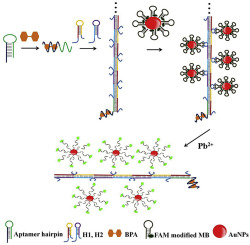当前位置:
X-MOL 学术
›
Anal. Chim. Acta
›
论文详情
Our official English website, www.x-mol.net, welcomes your feedback! (Note: you will need to create a separate account there.)
Dual enzyme-free amplification strategy for ultra-sensitive fluorescent detection of bisphenol A in water
Analytica Chimica Acta ( IF 6.2 ) Pub Date : 2018-08-01 , DOI: 10.1016/j.aca.2018.02.064 Wen Yun , Hong Wu , Lin Chen , Lizhu Yang
Analytica Chimica Acta ( IF 6.2 ) Pub Date : 2018-08-01 , DOI: 10.1016/j.aca.2018.02.064 Wen Yun , Hong Wu , Lin Chen , Lizhu Yang

|
An ultra-sensitive strategy for bisphenol A (BPA) detection based on dual enzyme-free strategies: hybridization chain reaction (HCR) and enzyme-strand recycling reaction has been developed. The BPA aptamer can form hairpins structure by the partly self-complementary sequence. In the presence of BPA, the released BPA aptamer sequence can trigger the HCR between two hairpins to from a long nicked double-helix DNA. The tails of hairpins on the duplex DNA were closely enough to hybridize with molecular beacon (MB) on the gold nanoparticles (AuNPs) to circularly cleave the loop of MB, leading to a "turn-on" fluorescent signal. This method exhibited high sensitivity for BPA detection in a linear rang from 0.2 to 1000 pM with 0.05 pM of limit of detection. Moreover, it was successfully used for BPA detection in real water samples. Importantly, this method was simple without complex enzymatic procedure and high cost, showing a promising future for on-site detection of BPA in practical application.
中文翻译:

用于超灵敏荧光检测水中双酚 A 的双无酶扩增策略
开发了一种基于双无酶策略的双酚 A (BPA) 检测超灵敏策略:杂交链反应 (HCR) 和酶链循环反应。BPA适体可以通过部分自互补序列形成发夹结构。在 BPA 存在下,释放的 BPA 适体序列可以触发两个发夹之间的 HCR,形成一个长切口的双螺旋 DNA。双链 DNA 上发夹的尾部足够接近,可以与金纳米粒子 (AuNPs) 上的分子信标 (MB) 杂交,从而循环切割 MB 的环,从而产生“开启”荧光信号。该方法对 BPA 检测表现出高灵敏度,线性范围为 0.2 至 1000 pM,检测限为 0.05 pM。此外,它已成功用于实际水样中的 BPA 检测。重要的,
更新日期:2018-08-01
中文翻译:

用于超灵敏荧光检测水中双酚 A 的双无酶扩增策略
开发了一种基于双无酶策略的双酚 A (BPA) 检测超灵敏策略:杂交链反应 (HCR) 和酶链循环反应。BPA适体可以通过部分自互补序列形成发夹结构。在 BPA 存在下,释放的 BPA 适体序列可以触发两个发夹之间的 HCR,形成一个长切口的双螺旋 DNA。双链 DNA 上发夹的尾部足够接近,可以与金纳米粒子 (AuNPs) 上的分子信标 (MB) 杂交,从而循环切割 MB 的环,从而产生“开启”荧光信号。该方法对 BPA 检测表现出高灵敏度,线性范围为 0.2 至 1000 pM,检测限为 0.05 pM。此外,它已成功用于实际水样中的 BPA 检测。重要的,

























 京公网安备 11010802027423号
京公网安备 11010802027423号